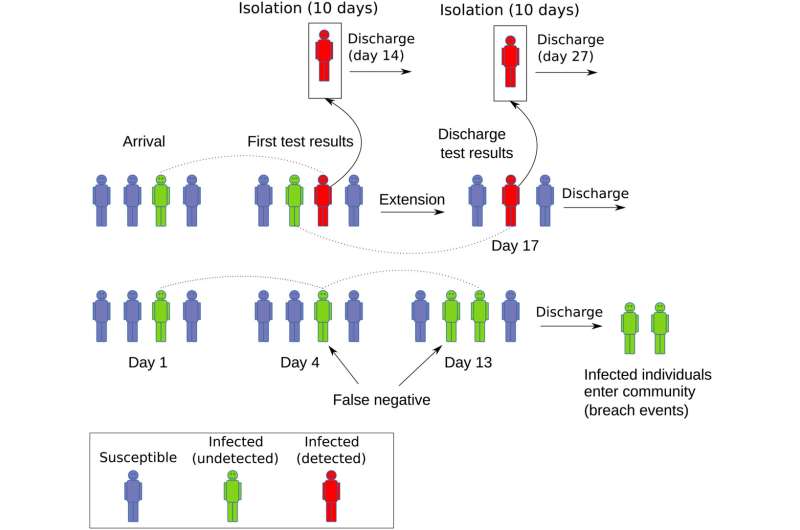World-leading simulation model to improve future pandemic quarantine response

A world-leading epidemiological simulation model to help improve future border quarantine practices for Australia and overseas has been developed by researchers at the University of Melbourne, the Peter Doherty Institute for Infection and Immunity and collaborating institutions.
The team of researchers—who advised the Federal Government on its National Plan to Transition Australia's National COVID Response last August—have published their model findings in the journal Sciences Advances.
The simulation model combines a detailed representation of person-to-person contact and virus transmission among both travelers and the quarantine workforce, with an accurate simulation of how infectiousness and virus testing accuracy varies over the course of a person's period of infection.
Researchers were able to include these factors into the simulation model by drawing on growing data from the operation of Australian hotel quarantine during the COVID-19 pandemic, and their inclusion can aid the design of quarantine systems to reduce the risk of virus transmission from infected arrivals in quarantine to the wider community.
Lead researchers Associate Professor Nic Geard and Dr. Cameron Zachreson, from the University's School of Computing and Information Systems (CIS), said the simulation model was developed to be adaptable and better calculate risks associated with various quarantine pathways including hotel quarantine, home quarantine and dedicated quarantine facilities such as the Victorian Quarantine Hub at Mickleham.
"We initially developed the simulation model in 2021 to help define effective quarantine pathways in the face of the Delta variant and the development of vaccines," Associate Professor Geard said.
"As the COVID-19 pandemic continues, the simulation model will enable us to model how we could use quarantine facilities should more severe COVID-19 variants emerge.
The simulation model can also allow for variations in quarantine duration, testing frequency for both arriving travelers and quarantine workforce, and response to a positive test such as isolating potentially exposed members of a traveling group and extending quarantine duration.
Associate Professor Geard said that beyond COVID-19, the simulation model will enable governments and planners to make evidence-based decisions about the various forms of quarantine for future pandemic responses.
"It will allow public health decision makers to estimate the risk of quarantine breaches in the event of a pandemic, and aid in the design of a quarantine system that balances the benefits of reducing quarantine breach risk against the associated costs to individuals and the economy."
Dr. Zachreson said the simulation model can be quickly adapted for future pandemic outbreaks as early data becomes available from the international research community.
"Our epidemiological model is an important Australian contribution to the global community that will help us all to be better prepared for future pandemics," Dr. Zachreson said.
"We worked with experts in epidemiology, statistics and public health to ensure our model was accurately calibrated to current data on COVID-19 infectiousness, testing accuracy, vaccine effectiveness and the set-up and operation of quarantine facilities."
More information: Cameron Zachreson et al, COVID-19 in low-tolerance border quarantine systems: Impact of the Delta variant of SARS-CoV-2, Science Advances (2022). DOI: 10.1126/sciadv.abm3624



















